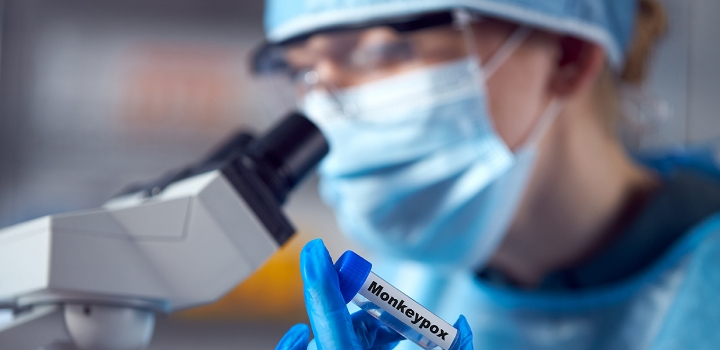Monkeypox: How it spreads, symptoms, prevention and more

The risk of coming into contact with monkeypox is low. However, it's important to be cautious of the disease and aware of how it differs from the flu or COVID-19, the way it spreads, how to prevent infection, its symptoms and more. We've summarised the most important, currently available information for you.
Yes, monkeypox is different to COVID-19
Here are some of the differences between monkeypox and COVID-19:
- Monkeypox is a well-known, typically rare viral disease that has been around for a long time. COVID-19 developed from a novel (newly identified) Coronavirus that quickly became ubiquitous globally.
- Monkeypox is significantly less contagious than the SARS-CoV-2 virus, which causes COVID-19. Importantly, to date, this outbreak of Monkeypox appears to be transmitted through direct bodily fluid contact, whereas COVID-19 spread posed a much higher person-to-person transmission risk through proximity to an infected individual. That said, more needs to be understood about Monkeypox's mode of transmission which seems to have changed, resulting in the current outbreak.
- Monkeypox is almost never fatal, and typically resolves spontaneously, consequently posing a low threat to healthcare systems. We are not at all likely to witness healthcare professionals and the healthcare system being severely impacted by this Monkeypox outbreak, to the same extent as COVID-19.
- It is highly unlikely to have the global healthcare and economic consequences of COVID-19.
How does monkeypox spread from animals to humans and between humans?
People can get monkeypox virus from contact with an infected animal, human, or materials contaminated with the virus:
- In endemic countries (endemic means it's long been present in an area or population), the monkeypox virus may be spread from handling infected bush meat, an animal bite or scratch, body fluids and contaminated objects. In Africa, monkeypox infection has been found in many animal species. However, some species of rodents (not monkeys as the name implies) are suspected of being the main disease carrier.
- In non-endemic countries persons are most likely to be exposed to monkeypox through contact with an individual that is already sick with monkeypox. Cases of monkeypox spreading through animals, outside of the endemic areas, are very rare, but may involve the exotic pet trade or potential through contact with infected animal-derived materials such as skins and leather.
The virus infects humans through broken skin, the respiratory tract, or the mucous membranes (eyes, nose, or mouth).
- Person-to-person transmission happens mainly through very close contact with the skin and mucosal lesions, body fluids, respiratory droplets and also contaminated materials such as bedding.
- The risks of infection appear to be increased in people who have multiple sexual partners, and there have been reports of increased spread at large social events where there is close physical contact.
- To date, the outbreak has been primarily in men who have intercourse with men.
What are monkeypox's symptoms?
- Monkeypox is a self-limiting disease with symptoms typically lasting from two to four weeks
- It usually presents with an acute illness characterised by fever and general flu-like symptoms, often followed by a blister-like rash on the skin
- The time from infection to symptoms (incubation period) for monkeypox is on average seven to 14 days but can range from five to 21 days.
- Within one to three days of onset of disease, blister-like lesions (similar to when we get chickenpox) develop on the face and the extremities including soles of the feet and palms of the hands, and possibly also on other parts of the body. These lesions go through several stages before scabbing over and healing.
- The disease is rarely fatal, and cases typically resolve without requiring treatment
- Severe cases may occur especially in new-born babies, children, and people with immune system deficiencies, but these are rare
How do we prevent monkeypox infection?
The risk of coming into contact with monkeypox is low. However, it's important to be cautious and aware. The best ways to prevent monkeypox infection are to:
- Avoid contact with people who are suspected or known to be infected with the virus
- Avoid contact with bedding and other materials that may be contaminated with the virus
- Practice safe sex, including the use of condoms and dental dams
- Wash your hands frequently with soap and water
What should you do if you think you have monkeypox?
The NICD says people with possible, probable or confirmed monkeypox should avoid close contact with others until all lesions have healed, and scabs dried off. This should include staying at home and self-isolating (unless you need medical assessment or care - also for other urgent health and wellbeing issues). Isolation stops transmission to others.
- Children and immunocompromised adults may experience more severe forms of the disease so it's important to limit their exposure to infected individuals.
- Treatment related to a possible or confirmed monkeypox infection is funded from DHMS members' available day-to-day benefits.
Get the facts from reliable sources
- In South Africa on the NICD website.
- Globally:
Find out more
Read our related articles for more information: